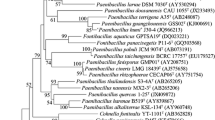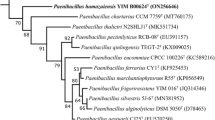Abstract
A Gram-positive, aerobic and non-motile actinobacterial strain, designated REN6T, was isolated from the mash of Baijiu (Chinese spirits, a kind of distilling liquor is made by cooking, saccharification, fermentation and distillation) collected from Sichuan Province Region, China, and characterized using a polyphasic approach. Morphological and chemotaxonomic properties of strain REN6T were consistent with the description of the genus Umezawaea, such as the spore arrangement, the abundant aerial mycelium and the fragmented substrate mycelium. The diamino acid of peptidoglycan is meso-diaminopimelic acid. The diagnostic phospholipids were DPG (diphosphatidylglycerol), PG (phosphatidylglycerol), PI (phosphatidylinositol), PE (phosphatidylethanolamine). The major fatty acids were C16:0, C17:0, Iso-C16:0, Iso-C16:1 H, C17:1ω6c and C17:1 ω8c. Menaquinone-9 (MK-9) (H4) was the predominant menaquinones. The genomic DNA G + C contents were 72.7 mol%. Phylogenetic analysis based on 16S rDNA gene sequences demonstrated that strain REN6T should also be classified in the genus Umezawaea, with U. tangerina (98.7%) and U. endophytica (98.7%). However, it can be distinguished from the closest strains U. tangerina JCM 10302T based on the low levels of DNA–DNA hybridization 22.1%. Based upon the morphological, physiological, chemotaxonomic and molecular characteristics differences from other members of the genus, a novel species, Umezawaea beigongshangensis sp. nov., is proposed, with REN6T (= JCM 33954T = CGMCC 19205T) as the type strain.

Similar content being viewed by others
References
Kinoshita N, Igarashi M, Ikeno S, Hori M, Hamada M (1999) Saccharothrix tangerinus sp. nov., the producer of the new antibiotic formamicin: taxonomic studies. Actinomycetologica 13:20–31
Labeda DP, Kroppenstedt RM (2007) Proposal for Umezawaea gen. nov., a new genus of the Actinosynnemataceae related to Saccharothrix and transfer of Saccharothrix tangerinus Kinoshita et al. 2000 as Umezawaea tangerina gen. nov., comb. nov.). In: High resolution spectrometry, 1978
Chu X, Liu BB, Gao R, Zhang ZY, Duan YQ, Nimaichand S, Chen W, Li WJ (2015) Umezawaea endophytica sp. nov., isolated from tobacco root samples. Antonie Van Leeuwenhoek 108:667–672
Borsodi AK, Pollak B, Keki Z, Rusznyak A, Kovacs AL, Sproer C, Schumann P, Marialigeti K, Toth EM (2011) Bacillus alkalisediminis sp. nov., an alkaliphilic and moderately halophilic bacterium isolated from sediment of extremely shallow soda ponds. Int J Syst Evol Microbiol 61:1880
Thompson JDT, Gibson TJ, Plewniak FM, Jeanmougin F, Higgins DGG (1998) The CLUSTAL_X Windows interface: flexible strategies for multiple sequence alignment aided by quality analysis tools. Nucleic Acids Res 25:4876–4882
Saitou N, Nei M (1987) The neighbor-joining method: a new method for reconstructing phylogenetic trees. Mol Biol Evol 4:406–425
Koichiro T, Glen S, Daniel P, Alan F, Sudhir K (2013) MEGA6: molecular evolutionary genetics analysis version 6.0. Mol Biol Evol 30:2725–2729
Kimura M (1980) A simple method for estimating evolutionary rates of base substitutions through comparative studies of nucleotide sequences. J Mol Evol 16:111–120
Li R, Li Y, Kristiansen K, Wang J (2008) SOAP: short oligonucleotide alignment program. Bioinformatics 24:713–714
Ruiqiang Z, Hongmei R, Jue Q, Wubin F, Xiaodong S (2010) De novo assembly of human genomes with massively parallel short read sequencing. Genome Res 20:265–272
Auch AF, Klenk HP, Göker M (2010) Standard operating procedure for calculating genome-to-genome distances based on high-scoring segment pairs. Stand Genomic Sci 2:142–148
Yoon SH, Ha SM, Kwon S, Lim J, Chun J (2017) Introducing EzBioCloud: a taxonomically united database of 16S rRNA gene sequences and whole-genome assemblies. Int J Syst Evol Microbiol 67:1613–1617
Cerny G (1978) Studies on the aminopeptidase test for the distinction of gram-negative from gram-positive bacteria. Eur J Appl Microbiol Biotechnol 5:113–122
Kodaka H, Armfield AY, Lombard GL, Dowell VR (1982) Practical procedure for demonstrating bacterial flagella. J Clin Microbiol 16:948
Waksman SA (1967) Actinomycetes; a summary of current knowledge. Actinomycetes
Gonzalez C, Gutierrez C, Ramirez C (1978) Halobacterium vallismortis sp. nov. An amylolytic and carbohydrate-metabolizing, extremely halophilic bacterium. Can J Microbiol 24:710–715
Hu HY, Lim BR, Goto N, Fujie K (2001) Analytical precision and repeatability of respiratory quinones for quantitative study of microbial community structure in environmental samples. J Microbiol Methods 47:17–24
Sasser M (1990) Identification of bacteria by gas chromatography of cellular fatty acids. USFCC Newsl 20:1–6
Hasegawa T, Takizawa M, Tanida S (1983) A rapid analysis for chemical grouping of aerobic actinomycetes. J Gen Appl Microbiol 29:319–322
Ezaki T, Hashimoto Y, Yabuuchi E (1989) Fluorometric deoxyribonucleic acid-deoxyribonucleic acid hybridization in microdilution wells as an alternative to membrane filter hybridization in which radioisotopes are used to determine genetic relatedness among bacterial strains. Int Syst Bacteriol 39:224–229
Acknowledgements
This work supported by The National Key Research and Development Program of China (2018YFC1603606), Coarse cereals and various beans processing project of modern agricultural industrial technology system of Hebei province (HBCT2018070206), and Science and Technology general project of Beijing municipal commission (KM202110011002). We are grateful to Zou Xiaohui, associate researcher at National Institute For Viral Disease Control And Prevention, China CDC with preparing transmission electron microscope.
Author information
Authors and Affiliations
Corresponding authors
Ethics declarations
Conflict of interest
The authors declare that there are no conflict of interest.
Additional information
Publisher's Note
Springer Nature remains neutral with regard to jurisdictional claims in published maps and institutional affiliations.
Qing Ren and Haiyan Chen have contributed equally to this work.
Rights and permissions
About this article
Cite this article
Ren, Q., Chen, H., Sun, Z. et al. Umezawaea beigongshangensis sp. nov., Isolated From the Mash of Baijiu. Curr Microbiol 78, 4127–4131 (2021). https://doi.org/10.1007/s00284-021-02656-w
Received:
Accepted:
Published:
Issue Date:
DOI: https://doi.org/10.1007/s00284-021-02656-w




